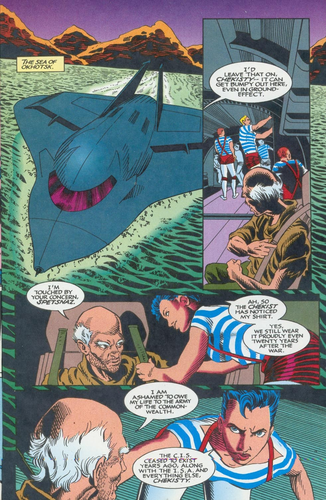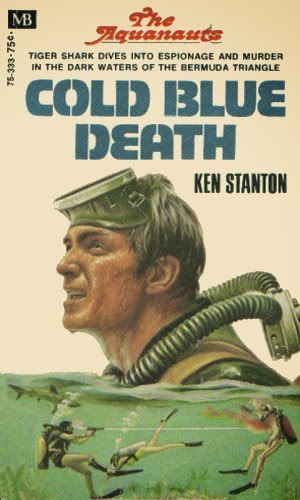Michael Jahn (Pen name:
J. D. Cameron),
Omega Sub, 1991
United States
USS Roosevelt
Aircraft Carrier, class not specified
Length: 780ft (238m)
Airgroup includes "...Advanced Harriers and the Sea King and LAMPS helicopters..."
No other details provided.
Note: Author refers to this carrier as being a CVV, this was a 1970s proposal for a conventionally powered Nimitz type carrier that was cancelled at the start of the Regan Administration for building further Nimitz Class Carriers. However the dimension given does not fit that design, which was 912ft long (278m), the competing Sea Control Ship proposal was for a carrier 620ft long (190 m).
Tzoli has suggested that the authors may have actually been thinking of a later SCS proposal called the VSTOL Support Ship, whose dimensions are a better fit for those given by the authors than either of the other two ships. (See the
Sea Control Ship (SCS) and VSTOL Support Ship (VSS) thread.)
USS John Quevedo (FFG-97)
Oliver Hazzard Perry Class Frigate
Details as per the real ships.
Note: Author does not explicitly state the class name, but gives dimensional details that exactly match a ship of that class.
USS Edders
Oliver Hazzard Perry Class Frigate
Details as per the real ships.
USS Tompkiss
Ticonderoga Class Cruiser
Fitted with "...Mark 2 Aegis Weapons Control System..."
Details as per the real ships
Note: The ships name does not fit the Ticonderoga Class naming scheme, but would fit the Arleigh Burke Class naming scheme. However the author describes this "...Aegis guided missile destroyer..." as having a Spruance Class derived hull which to my knowledge fits the Ticonderoga class better than the Arliegh Burke Class.
USS Liberator
Omega Class Submarine (SSN)
Length: 400ft (122m)
Beam: 37ft (11.3m)
Engine: Nuclear, a Westinghouse "...NCS Superfluid Metal Coolant Reactor..." driving three General Dynamics T7W Turbines connected to a single shaft.
Speed: 40knots (Cruise), 60knots (Flank), not specified if these are surfaced or submerged speeds.
Armament: 4 Torpedo Tubes, 40 x Mk.70 Torpedoes (Described as being "...long range, laser-guided, acoustic homing..." weapons. Range: 27,000yds (24.7km)), 24 x Mk.97N 'Anti-ship missiles' (Nuclear warhead.) (Range: 250mi (402.3km)) 2 x Blue Green Lasers
Electronics: Cyclops, combat display system. It takes all sensory data (radar/sonar/laser ranging/satellite imagery) to generate a 3-D image of the submarines surrounds, this is shown to the helmsman and commander via a holographic display unit.
Crew: 45
Description: "The teal-colored hull of Liberator moved swiftly, almost silently across the calm surface of the Bering Strait. Her lines were gently rounded, like the back of a propoise, and unmarred by ballistic missile tubes. Even the four torpedo tubes and the planes blended into the ship's overall gracefulness." Overall the appearance is apparently somewhat similar to the Soviet Victor class of submarines.
Note: Backstory states that the Omega Class is a successor to a fictional San Diego Class of Submarines. And, that only one unit was completed following a political backlash against nuclear power and military spending following the South American Wars.
Unspecified nation
'
Nemesis'
Identical dimensions and specifics to
USS Liberator, although the propulsion system appears to be different.
Described as a second Omega Class Submarine that was sold incomplete to a scrapper and thence to 'Greater Germany', its subsequent fate is unclear to the characters at this point in the series.
Note: The name is that given to the submarine by the crew of
USS Liberator, her actual name is not revealed until later in the series.
Plot summary: It is the early 21st Century. The United States most advanced submarine surfaces after a test run under the northern polar ice to find the world devastated by nuclear war, seemingly alone, the crew launch a desperate search for survivors.
Notes: This novel is the first in a series of six post-apocalyptic action novels published early 1990s by Avon Books as the 'Omega Sub' series. From what I've been able to learn about the series, it was clearly intended to run longer than the published six volumes with the last one apparently setting up plot threads for future volumes that were never published. One probable reason for this is the authors rather cavalier attitude to the use of nuclear weapons. The other is found at the end of the story where the author includes a brief statement that 'future historians' noted a particular event as being a key one in establishing the world they knew, thus indicating to the reader that no matter what happened in future books the heroes would win.
Like many action novels written during the late 1960s - early 1990s, the story is one that has a 'future of the past' quality. In this case the novels back story includes such things as a military campaign against South American drug lords in which tactical nuclear weapons were used on drug crops, the creation of an AIDS vaccine some time in the late 1990s. German re-unification resulting in the Germans being up to their 'old tricks' again, and a relaxation of gun control laws in the United States under the Quayle Administration in the late 1990s. For those who are not entirely familiar with 1990s US history, Dan Quayle was the United States Vice President during Bush the Elders years as President. Most well known for a series of public gaffes, Quayle lost to Clinton in 1992 and never ran for President again.
Other novels exhibiting this 'future of the past' quality I've covered are '
Seven Days in May' (1962) (
Charles W. Bailey II &
Fletcher Knebel), '
Thirty-Four East' (1974), '
The Hastings Conspiracy' (1980) (Both by
Alfred Coppel), '
The Crash of '79' (1976) (
Paul E. Erdman), '
North Star Crusade' (1976) (
William Katz), '
Side-Wall' (1982) (
David Graham), '
CV' (1985) (
Damon Knight), '
The Phoenix Odyssey' (1986) (
Richard P. Henrick), '
Rockets' Red Glare' (1988) (
Greg Dinallo), '
Debt of Honor' (1994) (
Tom Clancy) '
Rites of War' (1998) (
Cyn Mobley) and '
End Game', 2011 (
Matthew Glass), along with what is probably the most well known 'alternative history' sequence, '
Raise the Titanic' (1976), '
Vixen 03' (1978), '
Night Probe' (1981) & '
Deep Six' (1984) (All by
Clive Cussler) which are set in an alternative 1980s (The novels are set between 1987 ('
Raise the Titanic') & 1989 ('
Deep Six').) with many differences from what actually happened, most notably Canada being absorbed by the United States (Something Cussler quietly dropped in later novels.).



